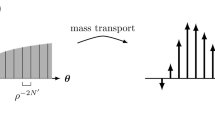Summary
The effective Hamiltonian of the model space perturbation theory (multilevel Rayleigh-Schrödinger theory) is expressed as an operator continued fraction. In the case of a nondegenerate model space the expression becomes an operator branched continued fraction. The method is applied to the harmonic oscillator with the kinetic energy treated as the perturbation and to the anharmonic oscillator.
Riassunto
L’hamiltoniana efficace della teoria della perturbazione di spazio modello (teoria a molti livelli di Rayleigh-Schrödinger) è espressa come una frazione operatoriale continuata. Nel caso di uno spazio modello non degenerato l’espressione diventa una frazione continuata operatoriale a branche. Il metodo è applicato all’oscillatore armonico con l’energia cinetica trattata come perturbazione e all’oscillatore anarmonico.
Резюме
Эффективный Гамильтониан пертурбационной теории модельного пространства (много-уровневая теория Рэлея-Шредингера) выражается, как операторная непрерывная дробь. В случае невырожденного модельного пространства полученное выражение превращается в операторную разветвленную непрерывную дробь. Предложенный метод применяется к гармоническому осциллятору с кинетической энергией, рассматриваемой как возмущение, и к ангармоническому осциллятору.
Similar content being viewed by others
References
B. Simon:Ann. Phys. (N. Y.),58, 76 (1970).
C. R. Garibotti andM. Villani:Nuovo Cimento A,59, 107 (1969);61, 747 (1969).
D. Bessis, P. Mery andG. Turchetti:Phys. Rev. D.,15, 2345 (1977).
D. Bessis andG. Turchetti:Nucl. Phys. B,123, 173 (1977).
J. Fleischer andM. Pindor:Phys. Rev. D,24, 1978 (1981).
M. Pindor andG. Turchetti:Nuovo Cimento A,71, 171 (1982).
G. Turchetti, F. Ortolani andC. Sagretti:Nuovo Cimento A,44, 211 (1977).
M. Barnsley andG. Turchetti:Comput. Phys. Commun.,22, 325 (1981).
S. G. Graffi andV. Grecchi:Lett. Nuovo Cimento,12, 425 (1975).
I. Lindgren:J. Phys. B,7, 2441 (1974).
T. T. S. Kuo, S. Y. Lee andK. F. Ratcliff:Nucl. Phys. A,176, 65 (1971).
W. Siemaszko:J. Comp. Appl. Math.,6, 121 (1980).
H. Denk andM. Riederle:J. Approx. Th.,35, 355 (1982).
B. Giraud:Phys. Rev. C,26, 1267 (1982).
G. Turchetti:Fortschr. Phys.,26, 1 (1978).
J. Des Cloizeaux:Nucl. Phys.,20, 321 (1960).
Author information
Authors and Affiliations
Additional information
Work supported by Phymat, Toulon University, 83130 La Garde, France.
Traduzione a cura della Redazione.
Переведено редакцией.
Rights and permissions
About this article
Cite this article
Pindor, M. Operator continued fractions and bound states. Nuov Cim B 84, 105–120 (1984). https://doi.org/10.1007/BF02721538
Received:
Revised:
Published:
Issue Date:
DOI: https://doi.org/10.1007/BF02721538




